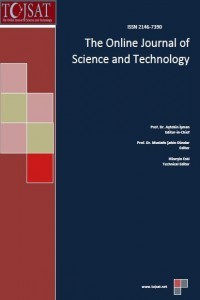Investigation of Changes of Pre-service Teachers' Opinions about Environmental Education with Drawing Analysis
Investigation of Changes of Pre-service Teachers' Opinions about Environmental Education with Drawing Analysis
drawings, environmental education, pre-service teachers,
___
- Ballantyne, R. & Packer, J. (2002). Naturebased excursions: school students‟ perceptions of learning in natural environments. International Research in Geographical and Environmental Education, 11(3), 218–236.
- Benedict, F. (Ed.). (1991). Environmental education for our common future: A handbook for teachers in Europe. Oslo, Norway: Norwegian University Press.
- Bogner, F. X. (1998). The influence of short-term outdoor ecology education on long-term variables of environmental perspective. Journal of Environmental Education, 29(4), 17–29.
- Dempsey, B. C., & Betz, B. J. (2001). Biological drawing: A scientific tool for learning. The American Biology Teacher, 63(4), 271-279.
- Dresner, M. & Gill, M. (1994). Environmental Education at Summer Nature Camp. Journal of Environmental Education, 25(3).
- Eaton, D. (2000). Cognitive and affective learning in outdoor education. Dissertation Abstracts International – Section A: Humanities and Social Sciences, 60, 10-A, 3595.
- Jordon, J. R., Hungerford, H. R., & Tomera, A. N. (1986). Effects of two residential environmental workshops on high school students. Journal of Environmental Education, 18 (1), 15-21.
- Keleş, Ö. (2011). Doğa Eğitimleri. Ed. Laçin Şimşek, C., Fen Öğretiminde Okul Dışı Öğrenme Ortamları, 117-130, Pegem Akademi Yayıncılık, Ankara.
- Keleş, Ö., Uzun, N., & Varnacı Uzun, F. (2010). Öğretmen adaylarının çevre bilinci, çevresel tutum, düşünce ve davranışlarının doğa eğitimi projesine bağlı değişimi ve kalıcılığının değerlendirilmesi. Elektronik Sosyal Bilimler Dergisi, 9(32), 384-401.
- Korkmaz, H. (2004). Fen ve teknoloji eğitiminde alternatif değerlendirme yaklasımları. Ankara: Yeryuzu Yayıncılık.
- Ozaner F. S. & Yalcin, G. (2000). Milli Parklarda Bilimsel Çevre Eğitimi, V. Uluslararası Ekoloji ve Çevre Sorunları Sempozyumu. (Ed. İlhami Kiziroğlu, Nelka İnanç ve Levent Turan), Ankara Alman Kültür Merkezi, 64–76.
- Palmberg, I. E., & Kuru, J. (2000). Outdoor activities as a basis for environmental responsibility. Journal of Environmental Education, 31(4).
- UNESCO-UNEP. (1985). Environmental Education: Module for Pre-Service Training of Social Science Teachers and Supervisors for Secondary Schools. Environmental Education Series 9, prepared at National Council of Educational Research and Training, New York, USA.
- Varnacı Uzun, F. (2011). Milli Parklar. Ed. Laçin Şimşek, C., Fen Öğretiminde Okul Dışı Öğrenme Ortamları, 117-130, Pegem Akademi Yayıncılık, Ankara.
- Yanık, F. E. (2006). Doğaperest. Ali Demirsoy Kitabı. Türkiye İş Bankası Kültür Yayınları, No: 950, İstanbul: 385-388.
- ISSN: 2146-7390
- Başlangıç: 2011
- Yayıncı: The association of science, education and technology
Intelligent Data Mining For Automatic Face Recognition
Ahmed RAGAB, Soumaya YACOUT, Mohamed-salah OUALİ
Pre-service teachers' perceptions about their own learning styles
Nina Hutnik, Boguslawa Wierzbowska, Krzysztof Piotrowski, Andrzej Matynia
A Fast Method For Accessing Nodes In The Binary Search Trees
İbrahim Ates, Mustafa Akpınar, Beyza Eken, Nejat YUMUSAK
Performance of different types of FRP sheets bonded to concrete using flexible adhesive
Removal of Cationic Dye from Textile Industry Wastewater with Using Enzyme, Fungus and Polymer
Mithat Celebi, Mehmet Arif Kaya, Melda Altikatoglu, Huseyin Yildirim
Hua-Yun Hsieh, Shi-Jer Lou, Ru-Chu Shih
Süleyman ÇELENK, Zeynep DEMİRTAŞ
De-inking paper sludge requirement of liming high acidic potato soil
Lotfi KHİARİ, Marie-jude MERİSİER, Antoine KARAM
Behavior of Staphylococcus aureus in a cheese produced by local lactic acid bacteria
